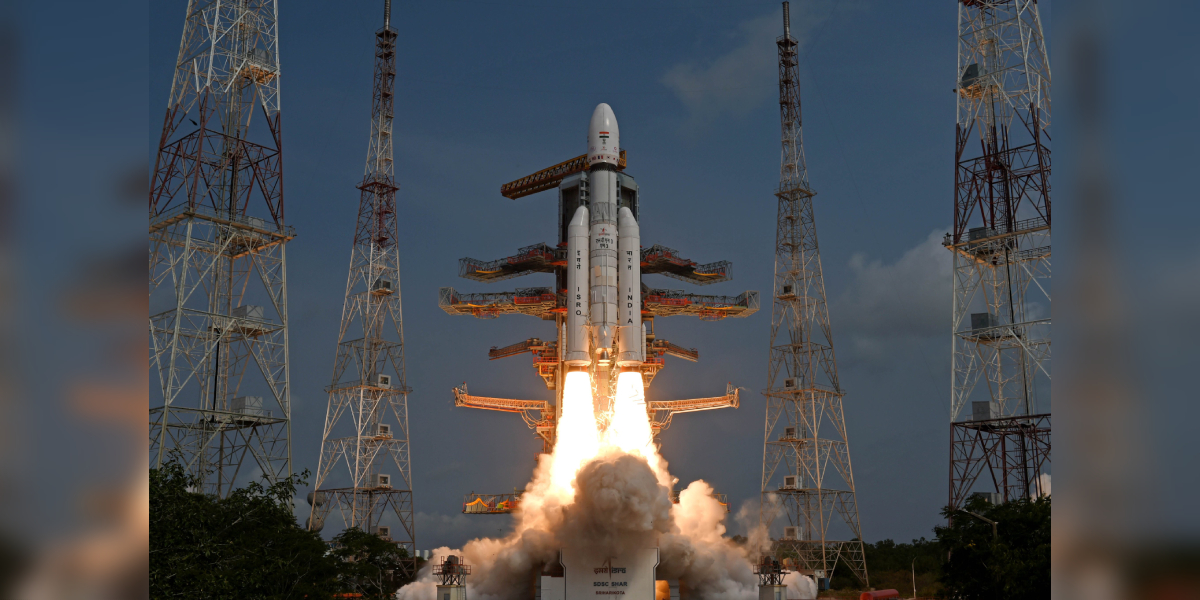The 43.5-metre-tall rocket blasted off at the prefixed time of 9 am on Sunday, from the second launch pad of the Satish Dhawan Space Centre.

This is the sixth flight of LVM3, which was earlier known as the Geosynchronous Satellite Launch Vehicle MkIII (GSLVMkIII) with a cryogenic upper stage. (Supplied)
In its second dedicated commercial launch, from Sriharikota in Andhra Pradesh, Launch Vehicle Mark-3 (LVM-3) — the heaviest rocket of the Indian Space Research Organisation (ISRO) — successfully injected all 36 satellites of the UK-based OneWeb into a Low Earth Orbit (LEO) on Sunday, 26 March.
After a smooth 24-and-a-half-hour countdown, the 43.5-metre-tall rocket blasted off at the prefixed time of 9 am on Sunday from the second launchpad of the Satish Dhawan Space Centre and put the satellites into their precise orbits.
This is the second dedicated mission for NewSpace India Limited, the commercial arm of ISRO.
The space organisation had signed an agreement with the UK-headquartered OneWeb Network Access Associates Ltd for the launch of 72 satellites into LEOs.
The first batch of 36 satellites of OneWeb was launched on 23 October.
Soon after take-off, the rocket sequentially deployed the satellites into multiple orbits.
While the first set of 16 satellites was being injected, it was announced that the remaining satellites would be placed into their intended orbits.
ISRO subsequently said, “LVM3-M3/OneWeb India-2 mission is accomplished. All 36 OneWeb Gen-1 Satellites injected into the intended orbits.”
It added: “In its sixth consecutive successful flight, LVM-3 carried 5,805 kg of payload to Low Earth Orbit.”
ISRO Chairman S Somanath congratulated NSIL, ISRO, and OneWeb for the successful launch of the mission.
“As we know, today the first 16 satellites of the series are already placed into the right orbit. And now it has gone into the far south of the Earth and we will be getting confirmation of the remaining spacecraft separation soon once the onboard storage data is acquired by our Indian ground stations,” he said while addressing scientists and guests at the Mission Control Centre.
The launch was the 18th for OneWeb, while for ISRO, it would be the second mission in 2023 after the successful launch of SSLV/D2-EOS07 in February.
“Till now, based on the observations, the vehicle has done extremely well. It went up to the right orbit and placed spacecraft at the right orbit, and also with very minimal disturbances to it,” Somanath noted.
Union Minister Jitendra Singh lauded ISRO for Sunday’s successful launch. “Proud to be associated with the department of space #ISRO at a time when India under PM @NarendraModi has emerged as the frontline Space Tech nation of the world,” he wrote on Twitter.
Proud to be associated with the Department of Space #ISRO at a time when India under PM Sh @NarendraModi has emerged as the frontline Space Tech nation of the world. Team ISRO adds yet another feather to its much decorated hat.Successful launch of LVM3-M3/OneWeb India-2 mission. pic.twitter.com/VqYSn5VMBO
— Dr Jitendra Singh (मोदी का परिवार) (@DrJitendraSingh) March 26, 2023
“Team ISRO adds yet another feather to its much decorated hat. Successful launch of LVM3-M3/OneWeb India-2 MIssion [sic],” the Union Minister of State (independent charge) Science and Technology said.
My best wishes and congratulations to the team at @isro on the successful launch of the LVM3 rocket from Satish Dhawan Space Centre in Sriharikota, #AndhraPradesh.
This day will always be remembered as an important milestone in Indian space history.— YS Jagan Mohan Reddy (@ysjagan) March 26, 2023
OneWeb now has 618 satellites in orbit, which is expected to be more than enough to launch global services later this year.
This mission marks OneWeb’s second satellite deployment from India, highlighting the collaboration between the United Kingdom and Indian space industries, the company said.
The first set of satellite separations (comprising four of the 36 satellites) took place around 20 minutes after lift-off, while the remaining were later deployed into their respective orbits in phases.
The satellites, after being placed into the low-earth orbits, would be divided among 12 planes at an altitude of about 1,200 km from Earth’s surface. Each plane would be separated by 4 km to prevent interplane collision, ISRO said.
This is the sixth flight of LVM3, which was earlier known as the Geosynchronous Satellite Launch Vehicle MkIII (GSLVMkIII) with a cryogenic upper stage. It had five consecutive missions, including the Chandrayaan-2.

Apr 26, 2024

Apr 26, 2024

Apr 26, 2024

Apr 26, 2024

Apr 26, 2024

Apr 25, 2024